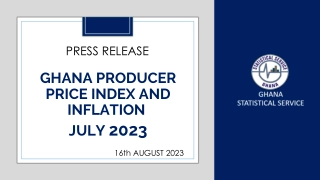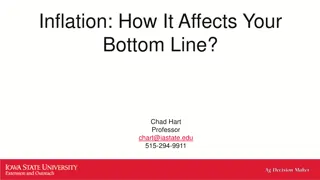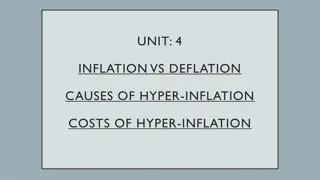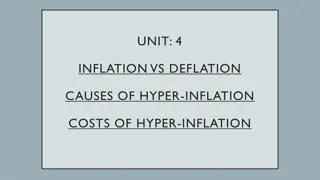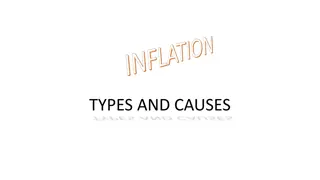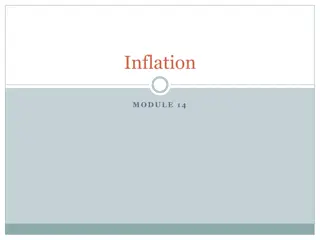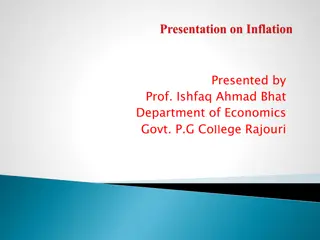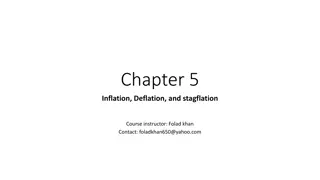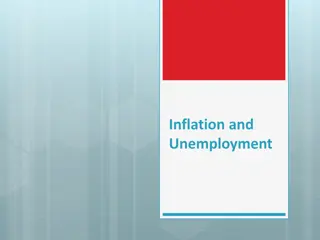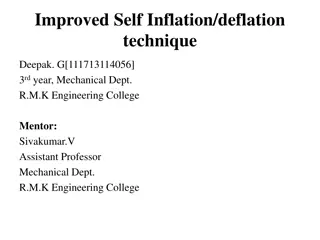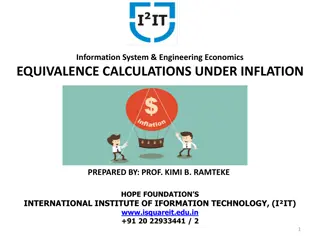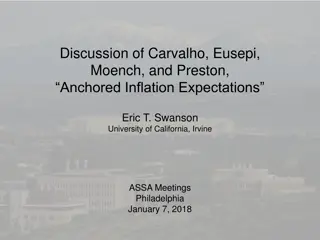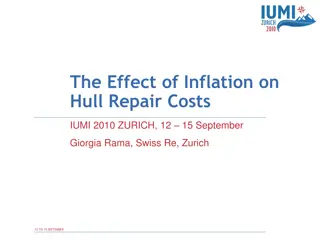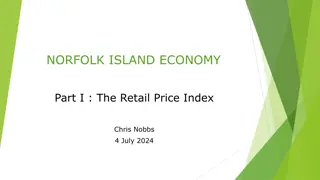Importance of Clear Communication in Inflation Targeting Framework
Inflation targeting emphasizes clear communication with the public and financial markets, enhancing transparency and accountability in monetary policy. By setting explicit inflation targets, central banks improve public understanding, encourage debate, and increase the accountability of policy-makers. Transparent communication reduces uncertainty, benefiting both the markets and the economy.
Download Presentation

Please find below an Image/Link to download the presentation.
The content on the website is provided AS IS for your information and personal use only. It may not be sold, licensed, or shared on other websites without obtaining consent from the author. Download presentation by click this link. If you encounter any issues during the download, it is possible that the publisher has removed the file from their server.
E N D
Presentation Transcript
Discussion of Cieslak, McMahon, and Pang, Did I Make Myself Clear? The Fed and the Market in the Post-2020 Framework Period Eric T. Swanson University of California, Irvine Review of the Federal Reserve s Monetary Policy Framework Brookings Institution June 14, 2024
Summary of Paper Thorough background on the 2020 FAIT framework many examples, anecdotes numerous quotes from FOMC members, news articles Discussion of successes and failures of FAIT framework anecdotal and informal, but insightful High-frequency analysis of interest rate changes around macro announcements and FOMC announcements/communications Textual analysis of newspaper articles using ChatGPT Interest rate expectations vs. term premium responses
Summary of Papers Conclusions The 2020 FAIT framework was a mistake designed to handle one specific problem difficult to communicate increased market uncertainty ended up constraining the FOMC I agree I agree I agree I agree I disagree Classic risk management approach better I agree Fed should be more explicit about bands around * shouldn t worry so much about small undershoots (or overshoots) I agree Fed should give scenario analysis Fed should publish Tealbook forecast and/or SEP details I disagree
Comment 1: Point of Inflation Targeting was Clear Communication One of the main points of inflation targeting was clear communication with financial markets and the public: Inflation targeting is characterized by two features: an explicit numerical target or target range for inflation and a high degree of transparency about forecasts and policy plans. (Bernanke, 11/14/2007) Among other important features of inflation targeting are vigorous efforts to communicate with the public about the plans and objectives of the monetary authorities and strengthen the central bank s accountability for attaining those objectives. (Bernanke, Laubach, Mishkin, and Posen, 1999, p. 4) The use of inflation targeting increases public understanding of monetary policy, improves policy-maker accountability (BLMP, p. 6) We see the inflation-targeting framework as serving two important functions: (1) improving communication between policy- makers and the public, and, not unrelatedly, (2) providing discipline and accountability in the making of monetary policy. (BLMP, p. 23) By making explicit the central bank s medium-term policy intentions, inflation targets improve planning in the private sector , enhance the public debate about the direction of monetary policy, and increase the accountability of the central bank. (BLMP, p. 23) Why spend so much effort on clarity and communication? The efforts by the inflation-targeting central banks to improve transparency and communication have been crucial to the success of the targeting regimes. (BLMP, p. 296) Increased transparency would also reduce the financial and economic uncertainty associated with the Fed s current procedures by giving the markets more information about what future monetary policies are likely to be. That would reduce substantially the costs incurred by financial analysts trying to guess what the Federal Reserve will do next and would make it easier for businesses and consumers to plan for the future, thus promoting economic efficiency. (BLMP, p. 311)
Comment 1: Point of Inflation Targeting was Clear Communication One of the main points of inflation targeting was clear communication with financial markets and the public: Inflation targeting is characterized by two features: an explicit numerical target or target range for inflation and a high degree of transparency about forecasts and policy plans. (Bernanke, 11/14/2007) Among other important features of inflation targeting are vigorous efforts to communicate with the public about the plans and objectives of the monetary authorities and strengthen the central bank s accountability for attaining those objectives. (Bernanke, Laubach, Mishkin, and Posen, 1999, p. 4) The use of inflation targeting increases public understanding of monetary policy, improves policy-maker accountability (BLMP, p. 6) We see the inflation-targeting framework as serving two important functions: (1) improving communication between policy- makers and the public, and, not unrelatedly, (2) providing discipline and accountability in the making of monetary policy. (BLMP, p. 23) By making explicit the central bank s medium-term policy intentions, inflation targets improve planning in the private sector , enhance the public debate about the direction of monetary policy, and increase the accountability of the central bank. (BLMP, p. 23) Why spend so much effort on clarity and communication? The efforts by the inflation-targeting central banks to improve transparency and communication have been crucial to the success of the targeting regimes. (BLMP, p. 296) Increased transparency would also reduce the financial and economic uncertainty associated with the Fed s current procedures by giving the markets more information about what future monetary policies are likely to be. That would reduce substantially the costs incurred by financial analysts trying to guess what the Federal Reserve will do next and would make it easier for businesses and consumers to plan for the future, thus promoting economic efficiency. (BLMP, p. 311)
Comment 1: Point of Inflation Targeting was Clear Communication In contrast, Cieslak, McMahon, and Pang provide extensive evidence that: the 2020 FAIT framework was vague by design policymakers themselves did not agree on details of the framework markets and press sought more clarity and were rebuffed term premia increased FAIT seemed to create market uncertainty, confusion in 2021 The 2020 FAIT framework was a giant step backward in communication and accountability
Comment 2: Communication Problems Sum of high-frequency market responses to: FOMC Chair Press Conferences Table IV: Announcements This should not happen with good communication, these columns should be uncorrelated instead, Fed Chair systematically contradicted the FOMC Clear evidence of a communication problem Related to the 2020 FAIT framework? Not clear.
Comment 2: Communication Problems Figure 11:
Comment 2: Communication Problems Swanson and Jayawickrema (2024): 2020-2023 press conferences were, ex post, a serious communications failure
Comment 3: Fed Was Not Very Constrained by Its Fwd Guidance Inflation in December 2021: percent change from 12 months previous
Comment 3: Fed Was Not Very Constrained by Its Fwd Guidance December 2021 Summary of Economic Projections: This does not look like the FOMC was constrained. It looks like they thought inflation would be transitory.
Comment 3: Fed Was Not Very Constrained by Its Fwd Guidance If the Fed had been constrained in December 2021: SEP interest rate forecasts would have been hitting the constraint instead, the FOMC soon set interest rates much higher SEP inflation forecasts would have been very high instead, they were very low Instead, it looks like monetary policy in late 2021 & early 2022 was set based on a bad assumption that inflation would be transitory.
Comment 4: Fed Should Publish SEP after Every Meeting Paper argues Fed should publish Tealbook, esp. staff forecast puts political pressure on staff creates significant risk of biasing staff forecast e.g., there have been times when staff forecast changed dramatically Instead, publish the SEP after every meeting: SEP is a fantastic resource e.g., June 12, 2024 FOMC release and it would be very helpful to have SEP for July 30-31 meeting avoids political pressure on staff forecast minimal additional work Not necessary to connect dots to forecasts SEP is extremely valuable as it is
Comment 5: Term Premium Fallacy Changes in the term premium do not necessarily have the same effect on the economy as changes in expected path of short rates Rudebusch, Sack, and Swanson (2007 FRBSL ER) The term premium can change for many reasons. Different reasons imply different effects on the economy. For example: Suppose a long-term real bond has no risk premium while comparable nominal bond has an inflation risk premium In equilibrium, firms & lenders are indifferent between the two rates If inflation risk premium goes up, in equilibrium, firms & lenders are still indifferent between the two rates Thus, higher term premium in this case does not imply lower investment
Summary Paper is an outstanding summary of Fed s post-2020 FAIT framework well-written, thorough, informative, many good examples and quotes Authors are fair but ultimately critical of FAIT Suggest Fed should return to risk management oriented approach going forward Some thoughts: 2020-2023 press conferences were a communications failure, not clearly related to FAIT Question the Fed story that it was constrained in late 2021 & early 2022 Argue for publishing SEP every meeting rather than Tealbook forecasts Effects of term premia are not necessarily the same as effects of changes in short rate expectations



